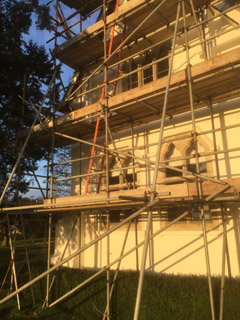 Not so much to report this month, as bee hives cannot be opened during the cold weather. This is to prevent loss of heat from the brood nest which could cause the death of developing bees, as well as of the adults if the weather is particularly cold (as it has been on occasion). All I’ve been able to do, therefore, is to check that the hive roofs are in place and have not been blown away by the wind (my top bar hive seems particularly prone to this, despite weighing a ton and being held down by a breeze block!) and also ensure that the bees have enough food to go into the winter.
Not so much to report this month, as bee hives cannot be opened during the cold weather. This is to prevent loss of heat from the brood nest which could cause the death of developing bees, as well as of the adults if the weather is particularly cold (as it has been on occasion). All I’ve been able to do, therefore, is to check that the hive roofs are in place and have not been blown away by the wind (my top bar hive seems particularly prone to this, despite weighing a ton and being held down by a breeze block!) and also ensure that the bees have enough food to go into the winter.
I do this by “hefting” the hive, ie lifting one side of the hive slightly off the ground, then going round to the other side of the hive and doing the same again. If the hive feels as if it’s “nailed to the ground”, that generally indicates there are sufficient stores in the hive – for now! It is a process that needs to be repeated throughout the winter months.
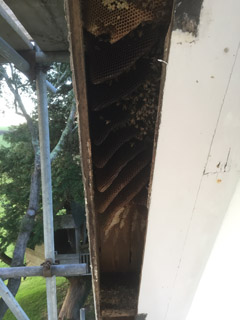 The wasps have finally gone for another year, but not without killing my small colony before they went. I have had my retribution, however, in that I have found so many queen wasps coming out from our curtains on sunny days which will no longer be able to make nests next year – I squished them! Unfortunately for me, there will be plenty of other queens who have gone elsewhere to hibernate, so there won’t be a shortage of wasps next year – sad to say!
The wasps have finally gone for another year, but not without killing my small colony before they went. I have had my retribution, however, in that I have found so many queen wasps coming out from our curtains on sunny days which will no longer be able to make nests next year – I squished them! Unfortunately for me, there will be plenty of other queens who have gone elsewhere to hibernate, so there won’t be a shortage of wasps next year – sad to say!
Last week I received a telephone call from a builder, who is renovating an occupied property (an old rectory), to tell me he had found a honey bee colony nesting behind the barge boards in the roof of the property. He sent me a photo so I could confirm that the insects were in fact honey bees (unlikely to be wasps or bumblebees at this time of year) – and they were!
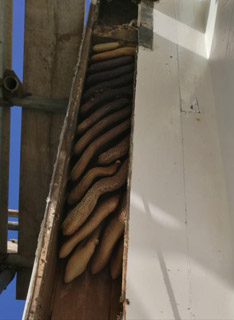 On Sunday, therefore, with only that day and the Monday forecast as being fine weather (rain was forecast for the two weeks following, which would have made the task almost impossible), I went over to have a look so I could tell him if it was feasible to remove them (he had made it quite clear that he didn’t want to kill them). Fortunately, the side of the house was scaffolded up to the roof (four floors – great!
On Sunday, therefore, with only that day and the Monday forecast as being fine weather (rain was forecast for the two weeks following, which would have made the task almost impossible), I went over to have a look so I could tell him if it was feasible to remove them (he had made it quite clear that he didn’t want to kill them). Fortunately, the side of the house was scaffolded up to the roof (four floors – great!
There’s nothing like a challenge! – but how much living accommodation do rectors need?!). Anyway, up I go and, sure enough, extending just beyond the barge board that had been removed, there was the comb and there were some bees – honey bees. Some food combs at the bottom of the nest appeared to have been broken away, leaving just the attachments to the roof boards that supported the slate roof, but apart from that there were 12 combs of varying size, mainly of dark comb, which suggested the bees had been there a long time – I mean years, not weeks! This would be some removal!
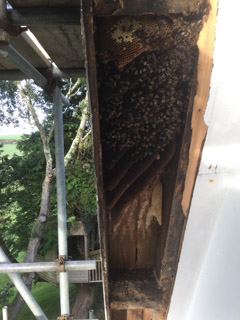 I returned home and phoned the builder explaining that I needed to remove another barge board, was that OK? Then I would have a fairly good chance of removing the comb intact, with any brood, food and bees attached. He agreed to that, so I had lunch and sat and thought about my approach.
I returned home and phoned the builder explaining that I needed to remove another barge board, was that OK? Then I would have a fairly good chance of removing the comb intact, with any brood, food and bees attached. He agreed to that, so I had lunch and sat and thought about my approach.
Initially, I had intended to return on the Monday but, having thought further, I decided to return on the Sunday afternoon, both to remove the barge board (which would likely upset the bees, so they would then have 18 hours to calm down before I started cutting out the comb the following day) and to feed them, as it looked as if their stores had been removed. I sprayed them with a 50/50 sugar solution, spraying some into their comb as well, so they would be alright at least until the following day and then removed the next barge board – with surprisingly little response from the bees, the darlings! This gave me better access to cut along the comb attachments and remove the combs intact. The bees were, of course, by now totally exposed to the elements and would need to use a lot of food to generate enough heat to keep them alive overnight but as there was no more I could do, I left them to it.
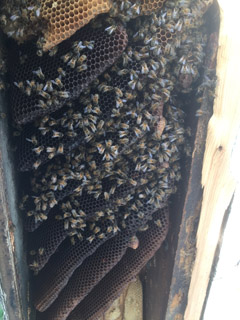 Monday morning arrives and off I go again – to a welcoming committee (they have good memories, these bees!). Undaunted, I started to cut out the comb, placing empty combs into a sealed bucket, so the bees couldn’t get at them, and tying occupied combs into empty frames which were then placed in a closed nucleus box. The bees kept trying to tell me something but I pressed on regardless until all combs were removed and all the bees (apart from those flying) were in the nucleus box.
Monday morning arrives and off I go again – to a welcoming committee (they have good memories, these bees!). Undaunted, I started to cut out the comb, placing empty combs into a sealed bucket, so the bees couldn’t get at them, and tying occupied combs into empty frames which were then placed in a closed nucleus box. The bees kept trying to tell me something but I pressed on regardless until all combs were removed and all the bees (apart from those flying) were in the nucleus box.
I placed the box with its entrance now opened adjacent to where the combs had been in the roof void (this meant climbing up to the fourth storey of the scaffolding with a hive of bees in my hands (don’t tell Lin, mind – though the views were fantastic!). I then went home and left the bees to it, anticipating that the flying bees would find their sisters and queen by their pheromones emanating from the hive.
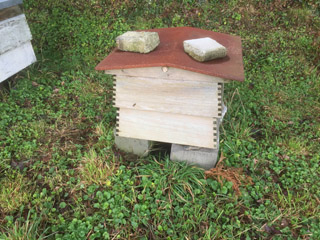 I returned to the property at the end of the afternoon, just as the light was beginning to fade, climbed up to the fourth storey, closed up the hive and brought it down to the ground. I then cleaned off the remaining comb attachments in the roof void, and brought the bees home.
I returned to the property at the end of the afternoon, just as the light was beginning to fade, climbed up to the fourth storey, closed up the hive and brought it down to the ground. I then cleaned off the remaining comb attachments in the roof void, and brought the bees home.
The following day, after a night in my bee shed (the bees, not me – I had a scotch in front of the log fire!), I placed the hive inside a WBC outer casing in my home apiary, since when the bees appear none the worse for their experience, as they are flying when the weather allows. Whether or not they will survive the winter remains to be seen but they at least now have a chance, which they did not have before. I’ll keep you posted.
Nothing more to report on the bee front, so I’ll wish you all a Merry Christmas and will write again in the New Year (so where did 2018 go?!).
Colin Rees – 01872 501313 – 07939 971104 – colinbeeman@aol.com
